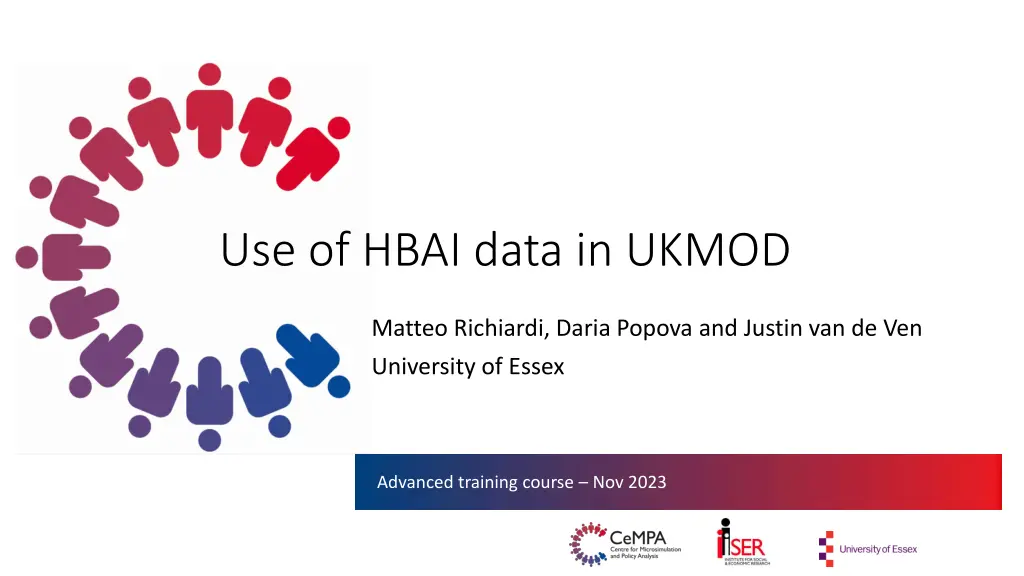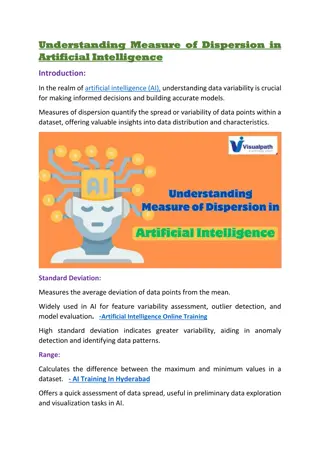
Understanding Integration of HBAI Data in UKMOD for Distributional Analysis
Explore the utilization of HBAI data in the UKMOD framework, comparing it with FRS data and highlighting its significance for distributional analyses of equivalised disposable household incomes. Learn about the integration process, variable mappings, and recommendations for selecting between HBAI and FRS datasets.
Download Presentation

Please find below an Image/Link to download the presentation.
The content on the website is provided AS IS for your information and personal use only. It may not be sold, licensed, or shared on other websites without obtaining consent from the author. If you encounter any issues during the download, it is possible that the publisher has removed the file from their server.
You are allowed to download the files provided on this website for personal or commercial use, subject to the condition that they are used lawfully. All files are the property of their respective owners.
The content on the website is provided AS IS for your information and personal use only. It may not be sold, licensed, or shared on other websites without obtaining consent from the author.
E N D
Presentation Transcript
Use of HBAI data in UKMOD Matteo Richiardi, Daria Popova and Justin van de Ven University of Essex Advanced training course Nov 2023
Overview FRS and HBAI Choosing between HBAI and FRS data Integration of HBAI data Comparative statistics 2
FRS and HBAI Family Resources Survey (FRS) Data available from 1993/94 Administered by DWP Finer detail concerning income sources than most other UK studies Substantial sample size (approx. 3 times the LCF) LCF income top-coded from 2006 Default data source for UKMOD Packaged for UKMOD from 2003/04, 2008/9, 2009/10, 2012/13+ Households Below Average Income (HBAI) data HBAI based on the FRS (from 1996) Adjustments to survey weights and income definitions for high income households evaluated using data from the Survey of Personal Incomes (SPI, administrative HMRC) Slight differences in sample 3
FRS and HBAI Gini of disposable household equivalised income (BHC) 40 39 38 37 36 35 34 33 32 31 30 1990 1995 2000 2005 2010 2015 2020 2025 HBAI Table 1.2 ONS: The Effects of Taxes and Benefits on Household Income, UK, 2021/22, Table 6a FRS (UKMOD default input from 2012) 4
Choosing between HBAI and FRS data General rule is to use HBAI data if focus is on equivalised disposable household incomes, especially for distributional analyses HBAI data is the basis for the DWP s HBAI publication Considered more appropriate for identifying distributional metrics for equivalised disposable income than FRS Complications with respect to UKMOD HBAI focus is disposable income Measures of original (private) income are imputed in HBAI used as input to UKMOD Slight differences in variable definitions (complicating comparisons) HBAI has slightly smaller sample size 5
How have HBAI data been integrated? New variables from HBAI integrated into input data sets: 2018(a4), 2019(a2), 2020(a2), 2021(a1, b1) A new policy over-writes FRS variables with HBAI variables The new policy is activated via a new model switch 6
Variable mapping from HBAI to FRS hbai_ypt_ind hbai_yiy_ind yptot, yptmp (private transfers) yiy, yiynt, yiytx, yittx, ydvtx (investment inc) + ypr, yprnt, yprtx (property inc) hbai_gs_pp hbai_ypp_ind hbai_yot_ind hbai_yem_ind hbai_yse_ind hbai_yds_ind dwt ypp yot01 (other) yem (employee) yse (self-emp) yds (disp inc) (weight) (pension) 7
The UseHBAI_uk policy Over-writes default model inputs reported by the FRS with values reported by HBAI 8
Results Model output using HBAI data can be analysed in the same way as standard model output 15
Comparative statistics Market incomes 1500 1400 billion (market prices) 1300 1200 1100 1000 900 800 2018 2019 2020 2021 2022 2023 2024 2025 2026 2027 FRS HBAI 16
Comparative statistics Government tax and NIC revenue 550 500 billion (market prices) 450 400 350 300 2018 2019 2020 2021 2022 2023 2024 2025 2026 2027 FRS HBAI 17
Comparative statistics Expenditure on benefits and tax credits 290 270 billion (market prices) 250 230 210 190 170 150 2018 2019 2020 2021 2022 2023 2024 2025 2026 2027 FRS HBAI 18
Comparative statistics Poverty rates (BHC equiv. incomes) 0.165 0.16 0.155 0.15 0.145 0.14 2018 2019 2020 2021 2022 2023 2024 2025 2026 2027 FRS HBAI 19
Comparative statistics Poverty rates (AHC equiv. incomes) 0.215 0.21 0.205 0.2 0.195 0.19 0.185 0.18 0.175 2018 2019 2020 2021 2022 2023 2024 2025 2026 2027 FRS HBAI 20
Comparative statistics Poverty lines (AHC equiv. incomes) 400 350 300 250 per week 200 150 100 50 0 2018 2019 2020 2021 2022 2023 2024 2025 2026 2027 FRS HBAI 21
Comparative statistics Gini of BHC equiv. original incomes 0.525 0.52 0.515 0.51 0.505 0.5 0.495 0.49 0.485 0.48 0.475 2018 2019 2020 2021 2022 2023 2024 2025 2026 2027 FRS HBAI LCF 22
Comparative statistics Gini of BHC equiv. disposable incomes 0.37 0.36 0.35 0.34 0.33 0.32 0.31 0.3 0.29 2018 2019 2020 2021 2022 2023 2024 2025 2026 2027 FRS HBAI LCF HBAI (reported) 23
Comparative statistics Gini of AHC equiv. original incomes 0.525 0.52 0.515 0.51 0.505 0.5 0.495 0.49 0.485 0.48 0.475 2018 2019 2020 2021 2022 2023 2024 2025 2026 2027 FRS HBAI 24
Comparative statistics Gini of AHC equiv. disposable incomes 0.39 0.38 0.37 0.36 0.35 0.34 0.33 0.32 2018 2019 2020 2021 2022 2023 2024 2025 2026 2027 FRS HBAI 25
Summary Now possible to project UKMOD from HBAI data Method to use HBAI data is very similar to standard FRS HBAI adaptation to capture high incomes may provide a more accurate reflection of aggregate taxes in UKMOD HBAI data suggest similar measures of poverty and inequality, in line with variation to official reported statistics Slightly higher inequality and poverty in HBAI due to extension of top of income distribution relative to static bottom. 26






















